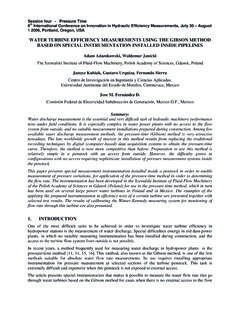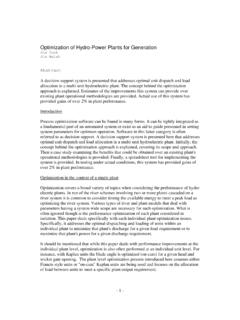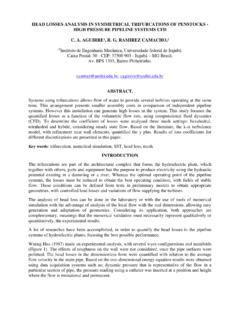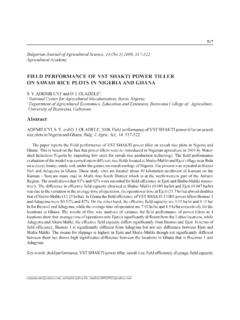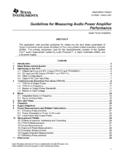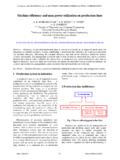Transcription of Generator Power Measurements for Turbine …
1 1 Generator Power Measurements for Turbine performance testing at Bureau of Reclamation Powerplants James DeHaan David Hulse Electrical Engineer Mechanical Engineer Bureau of Reclamation Denver, Colorado, USA Abstract To achieve low uncertainty in a hydroelectric Turbine performance test, the measured parameters should be obtained in accordance with the American Society of Mechanical Engineers (ASME) Power Test Code for Hydraulic Turbines and Pump-Turbines (PTC-18) or the International Electrotechnical Commission (IEC) International Code for the Field Acceptance Tests of Hydraulic Turbines (IEC 60041).
2 When the results of past runner replacement acceptance tests have indicated that a runner did not meet performance specifications, Reclamation has undertaken several investigations to determine if the problem was with the test method or data rather than the runner. Potential errors in the measured parameters such as head, flow, and Power were investigated. For the Turbine Power measurement , the Generator is used as a dynamometer whereby Power out of the Generator is measured and the Generator losses are added back to obtain the Turbine output. The Power output of the Generator is calculated by a wattmeter connected to the secondary voltage and current outputs from the unit potential and current transformers (PTs and CTs).
3 This equipment can be calibrated, but it is difficult because of the magnitudes of the high-side values and the physical size of the transformers. This paper will describe the steps taken to investigate the uncertainty of the flow measurement , electrical Power measurement , and Generator losses as well as error sources that were found. It also will address methods that can be used to reduce the uncertainty of hydroelectric Turbine performance test results by improving the accuracy of these Measurements . Background The Bureau of Reclamation is a United States federal agency that was created in 1902 to undertake water storage and irrigation projects in the 17 Western States to reclaim the west for human use and encourage settlement.
4 Reclamation has constructed more than 600 dams including the Hoover Dam on the Colorado River and the Grand Coulee Dam on the Columbia River. Reclamation is the largest wholesaler of water in the country and the second largest producer of hydropower with 58 hydroelectric powerplants and 194 generating units which range in output from 350 kW to 805 MW producing 44 billion kilowatthours of Power annually. Since the mid 1990s, Reclamation has focused primarily on managing existing water and Power related facilities. The Technical Service Center located in Denver, Colorado has 480 professionals with expertise in all aspects of water and Power related projects.
5 A Turbine and 2generator rehabilitation program, including field Turbine efficiency testing , is an integral component of Reclamation s focus on maintenance of existing infrastructure. Turbine testing is used to help investigate uprate potential, re-allocate unit dispatch based on Turbine efficiency (optimization) and, most importantly, verify that replacement runners meet contract guarantees. Measuring the parameters to calculate Turbine efficiency is a relatively easy task, but achieving a low uncertainty on each of the Measurements is relatively difficult, requiring expertise, experience, and the ability to adapt to each individual hydro unit.
6 To achieve low uncertainty in a hydroelectric Turbine performance test the measured parameters must be obtained in accordance with the American Society of Mechanical Engineers (ASME) Power Test Code for Hydraulic Turbines and Pump-Turbines (PTC-18) ) or the International Electrotechnical Commission (IEC) International Code for the Field Acceptance Tests of Hydraulic Turbines (IEC 60041). Electrical Measurements are covered in section 4D of the 2002 ASME code. Reclamation has been performing field Turbine testing for decades and has been active on the PTC-18 committee for many years.
7 When the results of runner replacement acceptance tests indicate that a runner did not meet performance guarantees, investigations are undertaken to determine if the problem is with the test, test data, or the runner. Some of the measurement methods that are investigated include the flowmeter installation and the Generator Power output measurement . When testing to calculate runner efficiency, the Generator is used as a dynamometer. Power out of the Generator is measured and the Generator losses are added back to obtain Power input to the Generator which is the Turbine output.
8 The accuracy of the Generator loss data also has been investigated. Flow measurement The measurement that often has the highest uncertainty is the flow rate. At Grand Coulee the flowmeter in the G-17 penstock was an eight-path time-of-flight acoustic meter with the metering section just downstream of a 21-degree reducing bend. The transducers were installed by the flowmeter manufacturer as part of the rehabilitation contract. To investigate the accuracy of this measurement , the meter was upgraded by the flowmeter manufacturer to an 18-path meter to achieve lower uncertainty.
9 The addition of 10 paths to the flowmeter resulted in a slight correction factor to the flow measurement . The calculated Turbine efficiency increased by percent because the additional acoustic paths better represented the velocity profile downstream of the penstock reducing bend. Generator Power measurement The Power output of the Generator is calculated by a wattmeter with inputs of voltage and current measured at the secondary side of the PTs and CTs. PTs and CTs simply transform Generator line voltage and current to lower values that can be safely measured by normal plant instruments.
10 The calibration of the PTs and CTs and the burden on each can be measured, but it is difficult because of the magnitudes of the high-side values and the physical size of the transformers. 3 Grand Coulee G-17 Power measurement Investigation Following the runner acceptance test the electrical Power measurement uncertainty was investigated. The electric Power output was measured by a calibrated two-element wattmeter connected to the secondary voltage and current outputs from the unit PTs and CTs. These outputs are accessible at the unit control board. The uncertainty of the Power measurement was originally estimated to be the root square sum (RSS) of the nameplate uncertainty of the PT, CT, and watt transducer.
